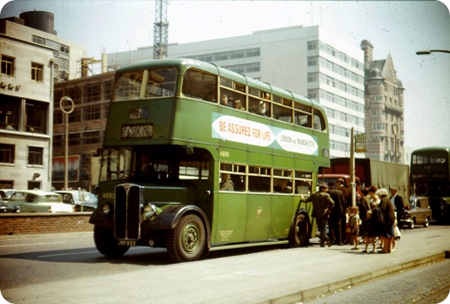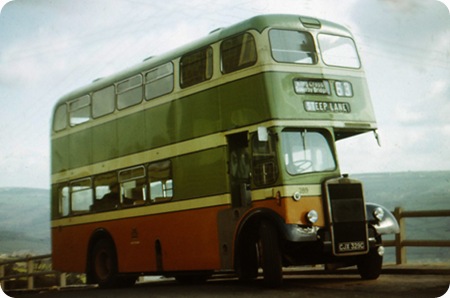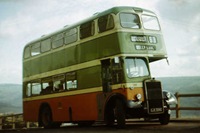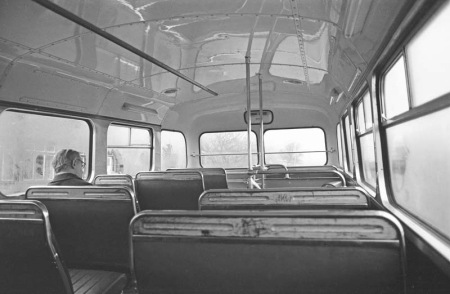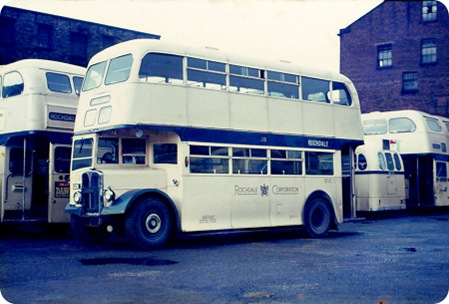
Rochdale Corporation
1949
AEC Regent III
Weymann H33/26R
Memories of the No. 17 from Manchester Cannon Street to Rochdale in the 50’s
Mullion
Not strictly true, not the original colour scheme of the time. Good photo though!
Ian Buckley
One of the early Rochdale Regent IIIs turned over at the junction of Broadway and Middleton Road, Chadderton on May 1st 1951 after colliding with an Oldham PD1. The Rochdale bus was returning from Manchester with a full load – 55 people were injured. For years I have been trying to identify just which two buses were involved. If you know please leave a comment.
The Rochdale Observer cutting has a picture of the bus lying on its side, photo credited to D Worrall.
Peter Greaves
I’ve seen a very good quality photo of this incident in the GMTS archives. That could be your next port if you’re hoping to further enquiries on this?
The Rochdale bus was actually lying on its nearside on Broadway just past Hunt Lane but well before Middleton Rd, and facing towards Royton. There’s no evidence in the photo that any other vehicle was involved.
It is possible that another vehicle could have come out of Hunt Lane from the right and collided with the Rochdale bus causing it to overturn, but Hunt Lane was not on an Oldham bus route.
On the left at this time you may recollect there was a large coal yard served by a railway branch off the Werneth to Middleton Junction line, and this too is visible in this photo.
I was talking very recently to a gent who says he knew a woman who had been travelling on the bus, and for a long time afterwards she still had her head bandaged. He seems to think the incident happened about 1957, but I’d certainly go with the date you have if it’s confirmed especially by a newspaper. This was a very serious accident and this gent thought there had been some fatalities?
From the photo it actually appears that the bus was one of the 8 footer Weymanns, and a friend and I always concluded that this was probably 222 as it was the only one of the batch we had never been able to spot!
Peter Gould’s Rochdale fleet list has 222 as the first of the batch to be withdrawn in 1963, but it may well have sat in the works being cannibalised for many years following the accident?
On the other hand it may have been a completely different bus, and it may have been rebuilt and returned to service, but in the photo I’ve seen it looks too badly damaged. This shot has been taken from above and behind the bus and the roof appears to have become detached from the body at the rear.
I was never able to gain access to the inner sanctum at Mellor St, but I feel sure there must be others out there able to throw more light on this incident,
Keith Jackson
Could you please tell me what colour the bus was that ran from Rochdale to Bacup in about 1969.
Thanking you
Fiona
Rochdale Corporation buses sported a very attractive Oxford Blue and cream livery applied in a streamlined style with the blue side panels on both decks ‘swooping’ down to give an all cream front. When the ‘new look’ fronted Daimler CVG6’s and AEC Regent V’s arrived in 1953 and 1956 respectively, the tin fronts were painted blue. All were bodied by Weymann. The body style was to the traditional design which pre-dated the Orion and the curvaceous lines of this body blended superbly with the Rochdale streamlined livery. In my view the Regent V’s were some of the most attractive British buses ever built.
In around 1961 Regent V 277(NDK 977) was painted in the style of livery shown above as an experiment to allow spray painting to be used to save costs. It was said the livery needed to be simplified to allow this method of painting to be adopted. The ‘Rochdale Corporation’ fleet name straddling the crest was introduced on this bus. Later in the year AEC Regal IV saloon no 12 and Daimler CVG6 238 (I think) both appeared in this style, initially with a lighter blue band. This was very quickly modified to the Oxford Blue darker standard colour.
At first these vehicles seemed well received as it was something different but it was a sad day in my view when it was announced that this livery was to adopted as standard. It took to sometime for the whole fleet to be repainted and I recall that a few of the Regent III’s were the last vehicles in the old livery.
After being a very smart fleet, Rochdale’s buses seemed to take on a care worn appearance towards the end of their independent life before being swallowed into SELNEC. The cream livery soon showed dirt on the lower panels in the industrial environment of a Lancashire mill town and one must question the wisdom of adopting such an inappropriate livery.
To answer Fiona by 1969 the Rochdale fleet had been absorbed into SELNEC and the buses operating on the 16 route to Bacup would have been in SELNEC orange and off-white but again it took some time for all vehicles to be repainted and there would have been cream and blue examples in the former Rochdale livery still about at this time.
Philip Halstead
I love the art-deco style of writing on the side of these vehicles.
Chris Hebbron
The accident Rochdale bus 222 was involved in was in the early 1960s and Peter Gould’s withdrawal date of 1963 would stack up. After the accident the bus was parked under a tarpaulin on the parking ground which RCT was temporarily using during the construction of the Mellor Street depot extension. (This site was opposite Hansons Spring Works located on the eastern side of Mellor Street and bordered by the River Spodden – on the southern side of the river where it passed under Mellor Street). I seem to recall that 222 was working service 3 along Milnrow Road somewhere between Kingsway and Witley Road.
David Slater
So 222 was involved in a completely different incident, wonder if this was also an overturning?
That on Broadway Chadderton was just before Middleton Rd, and on route 90. The photo I saw in the GMTS archives would suggest it was nearer to 1951 given the onlookers in the photo and how they were dressed.
The bus was definitely one of the postwar AEC Regent III/Weymann’s but the reason I can’t positively identify the bus here is because there isn’t that degree of definition in the photo.
As I said in the earlier posting, the bus looks badly damaged, with the roof detached from the body at the rear, but in 1951 it would still have quite new, so perhaps economic to repair? Interestingly only 222 of all the Regent IIIs was withdrawn prematurely, so the indication is that this bus was returned to service.
It was a matter of local folklore for many years that a 90 bus had overturned on Broadway, but nobody knew which fleet it was from, Oldham, Manchester or Rochdale, or the precise location of the accident, which only became known to me when I saw the archive photo.
It might be worth another look but you have to be a member of the GMTS to gain access to their archives. I no longer am, but I know a man who is. It would be interesting to be able to get to the bottom of this incident.
Keith Jackson
Another possible clue as to the identity of the overturning Regent III. As they aged some of the batch were rebuilt with rubber mounted windows mostly at the front upper deck as per the above photo.
However pics on Jasper’s link below show refurb work carried out to bus 210. This and following shot show the major work involved, as if it had been carried out by Weymann to contemporary styling being used on the Aurora body: //jasperstransportphotographs.fotopic.net/p54432950.html
Are we getting nearer I wonder?
Keith Jackson
The refurbishments look superb – and a sight better than North Western did with 253 (a contemporary PD2 in nearby Oldham) when they refurbished it.
David Oldfield
02/03/11
I believe that the vehicle involved in the Chadderton incident was 7ft 6in Regent III No 39. Subsequently it appears to have been rebodied by Weymann before being returned to service. Its interior polished wooden cappings around the windows were then of the later, rounded, style as used on the 1949-51 Weymann bodies rather than the flat style of the rest of the 31- 48 series.
Ian Holt
Hi Ian, Many thanks for the above info. I have no reason to doubt what you’re saying re 39, but is there any absolute evidence to confirm it was this bus?
I jumped to the conclusion of it perhaps being 210 because of the extensive rebuilding that bus’ body received, and certainly from the only photo I’ve ever seen of the accident, the body does look very badly damaged, so much so that rebodying would be a distinct possibility.
I’ve been unable to ascertain the identity of the overturner try as I might. Perhaps the more comprehensive PSV Circle or Omnibus Society lists (unfortunately not in my possession) have this information?
I’ve not been able to read the Venture book on Rochdale, but maybe the info is in there? Also as Peter who initiated the topic has said, is there any evidence supporting the allegation that an Oldham PD1 was also involved in this accident?
Keith Jackson
18/04/11 – 05:00
Regarding 222, it was in a head on accident with an artic on the undulating stretch of the A58 between the road to Wardle and the road down to Smithy Bridge station and Hollingworth Lake. I believe the bus driver was killed outright and there were no passengers on it. I have some negatives on 6×9 B&W of 222 after towing to Mellor Street and before it was stripped for spares and parked on the spare land for at least a year – have a couple of negs there as well.
I’m sure the accident was sometime in 1963 and could probably be found in the Rochdale Observer archives.
A rear view of nearside shows the body substantially bent, and as not much older buses were being withdrawn then it was obviously not worth repairing.
Anon
23/04/11 – 08:24
By chance I’ve found a photo online of this accident which makes it very clear it was 39 – see
//oldhameveningchronicle.newsprints.co.uk/view/16707219/q5451_jpg
Possibly a few orders coming along for that one judging by the interest!
David Beilby
24/04/11 – 07:41
I notice that the date of the photograph of 39 is shewn as 1st January 1951.
Chris Hebbron
24/04/11 – 15:54
Note many of the photograph dates are inaccurate – that one is quite close by comparison! It’s also the convention I used on my erstwhile Fotopic gallery when all I knew was that the photo was taken in 1951.
David Beilby
04/06/11 – 06:40
David, Thanks so much for the link to the photo. New Years Day 1951 not only sounds ominous but also perhaps slightly implausible as a Public Holiday? Given that the 90 was only ever in any case a peak hour service.
Might suggest an element of driver culpability though…. ? Certainly looks a very nasty accident, and the photo in the GM Museum from the rear perspective looks even more devastating. I understand that there were fatalities.
Keith Jackson
05/06/11 – 14:14
The sequence of 5 photos here from the Oldham Chronicle website:
A very strange accident this for a number of reasons. To have ended up on its nearside in the position the bus lies could suggest it went into a skid to the offside, and reasoning might suggest it would have tipped to the offside and turned over instead onto that side?
What is evident from a couple of the photos is that bus overturned a distance before it came to rest given the marks along the carriageway?
Also its positioning before the junction indicates there was no jumping of the lights, although heavy braking in less than ideal road conditions could have been contributory?
In one of the photos there is just visible the rear corner of an Oldham Roe bodied bus…. Perhaps this was after all involved, and been moved away to help aid recovery of the Rochdale bus?
In the case of Oldham PD3 108 overturning onto its nearside, that was much easier to explain, as it was hit at the front nearside by a tanker lorry, which then caused it to spin tipping to the nearside.
The saga of Rochdale 39 still has much to it which is unknown.
Keith Jackson
07/06/11 – 09:26
A grim but fascinating set of pictures which leave as many questions as they solve. Going by the way in which the roof of the bus has been torn off "upwards" and the front section show heavy wrinkling to confirm that, the direction the vehicle took before coming to rest must have been sliding on it’s nearside and indeed the nsf mudguard is distorted to confirm. Then looking at the pattern of the fluids draining from it, it would seem the bus was travelling downhill prior to the accident.
Now looking at the first picture, the just visible second bus is facing away so had it just turned right and No.39 came to grief behind it? Purely as a theory, could 39 becoming downhill maybe quite fast, saw the bus in front stopped waiting to turn right, panic braked, skidded, tried to correct but instead toppled onto the nearside and slide downhill to rest but turned through say 300 degrees as it did so?
The injuries must have been dreadful and no doubt there are people alive with family memories. Maybe a letter to the local newspaper may bring some accurate clues or information.
Richard Leaman
Hi Richard,
Some interesting observations. Your thoughts are the most logical. There’s a possible red herring, in that the overturned bus shows Rochdale on the blinds, implying it was heading from Manchester and overturned in its direction of travel just before the junction.
Yet the positioning of the overturned bus, the Oldham bus, evident liquid spillage in the junction beyond (from Photo 1 – despite the copyright text), and as you say, apparent evidence of the roadway marks from the tyres and front wing of the overturning bus suggest otherwise.
The assumption it was travelling from Manchester would be an easy one to make, even if this came from contemporary reporting. However having looked at the accident from numerous aspects, my reasoning goes:
I now think that the bus was travelling from the opposite direction as you say, towards Manchester in fact. The 90 route was a non-stopper between Royton and Manchester, and as there would be no more boarders, the crew may have already set the blinds for the return trip. This was not unknown in the days I remember the 90.
I initially thought it unlikely the Regent had been broadsided by the Oldham bus crossing the junction either straight across Middleton Rd or turning right into it from Broadway, because it appears to have come to rest before the junction, and I assumed the evident carriageway scuffing implied it had overturned prior to it.
Whereas apparent evidence now seems to have it heading the other way, and in fact overturning beyond the junction. Its otherwise nigh on impossible to explain. I have some alternative theories but they’re weak ones.
For the Regent to land on its nearside is also hard to explain other than by it being broadsided from the offside. If it was after all heading towards Rochdale, to land how it has done suggests it would have skidded to the offside and this would have induced offside tilting instead. The nature of the roof damage sustained would also be hard to explain, given drag rather than compression? This also seems to indicate a high speed overturning.
There’s a further photo in the GM Museum archives which looks to have been taken from the bedroom window of the house overlooking from the rear of the bus. There is a big offside dent on the Regent on the lower panels just behind the drivers cab. This is pretty compelling evidence it was broadsided.
Other important considerations. Accident was said to have happened on 1st of May 1951, newspaper evidence seems to support this. This was a Tuesday. Route 90 operated in the morning and evening peaks only on Mondays to Fridays. It’s said there were 55 injured on the bus, so a full bus. By far the predominant flow of passenger traffic was from Rochdale towards Manchester in the morning peak,reversed in the evening peak. My dad was a regular user of the route.
I don’t know if there’s any conclusions to be drawn from the school children present amongst the onlookers?
I’m still intrigued to find out more about this accident, though fear I may be at the point of starting to bore readers with the ongoing saga! I’d welcome anyone with an interest to contact me ask Peter for my email address Next stop Oldham Chronicle and Rochdale Observer news archives.
Keith Jackson
10/06/11 – 09:47
Keith, far from being bored, I always relish a mystery like this, and I suspect other readers do too. Those who don’t can always ignore it! Please don’t deprive us of further reasoning by making it a private affair – Hercule Poirot would be proud of you!
Stephen Ford
02/07/11 – 07:07
I’m sure it has already been tried, but has anyone contacted the Police? Chadderton at the time was under the Lancashire Constabulary and not GMP as now. There must be information stored somewhere on this accident?
TonyC
02/07/11 – 11:55
Hi Tony, You’re absolutely right, that was to be my next port of call, having drawn a total blank so far with the Oldham Chronicle. Even were it is possible to produce an archived news article that could be erroneous for some of the circumstances outlined above.
I’ll try both Lancs and GMP, but am wondering whether Chadderton actually came under Oldham’s rather than Lancashire’s Constabulary at the time?
One observation Richard makes is that where 39 is lying, it looks as if fluids could be draining from it, but the slight downhill slope here and the one prevailing at the junction, is into the far distance of the photo. Still suggesting that it was heading towards Manchester and that on overturning its spun through over 90 degrees to suggest it might have been travelling in the opposite direction.
A broadside from a right turning bus on the junction seems ever more the likely outcome?
Keith Jackson
02/07/11 – 16:21
I’d’ve thought the best place for information on the accident would be the County Records Office (sometimes known as County Archives).
Chris Hebbron
03/07/11 – 05:52
It was definitely Lancashire Constabulary. Oldham was an independent Borough Force at the time. It (Oldham) only went into Lancashire Constabulary in April 1969, along with many of the old Borough Forces in the County. They then became part of Greater Manchester Police in 1974 (I think that was the date) I know this for fact. I was in the old Rochdale Borough Force at amalgamation in 1969!
TonyC
11/07/11 – 13:56
Good Lord Tony! My brother was also a serving officer at Rochdale, but by then under GMP.
Keith Jackson
12/07/11 – 14:00
I never served with GMP. I left in July 1969 and transferred to Sussex Police. The only ‘JACKSON’ I knew was a Pete Jackson who lived Smallbridge way but that was in the ‘dying days’ of the old Rochdale Borough Force.
Whilst I am typing this, does anyone have any old photos of the Rochdale buses in the old (mainly blue) livery? How I wish that camera capabilities today were available then!!
TonyC
30/07/11 – 07:54
Hi Tony, brother was Tony Jackson, served at Collyhurst, Rochdale and finally Milnrow. All under GMP.
Anyhow further info just come to light concerning 39 and the overturning incident. Seems I’ve been making various assumptions that have turned out to be incorrect, e.g. placing the bus on the wrong side of the junction for a start.
More to follow shortly, with a link to another photo of the incident which has helped to explain quite a few things.
Keith Jackson
Re Rochdale 39 and its overturning. Thanks are due in no small way to both John Holmes and Fr Norman Price in helping to unravel the details of this accident.
Fr Norman’s website “Delta 64” links to a further photo here:
Keith Jackson
21/08/11 – 16:28
Unfortunately, I’ve trawled the site and can’t find any connected pictures?? Any ‘clues’?
TonyC
22/08/11 – 11:32
Here it is Tony. In case (as I just did) you get directed to the homepage, the pic is on page 49. Once there you need to scroll down the page.
//www.fireflash-delta64.co.uk/cca49.html
Keith Jackson
23/08/11 – 09:43
Thanks Keith. Excellent picture too!
TonyC
23/08/11 – 09:45
Keith Thank you for linking the picture which is interesting. I really have never been to the area so have no clear idea of the road layout or directions but, this later picture does show an impact on the offside although I would have thought not so heavy as to be enough to cause the severity of the resulting accident. So, maybe the driver of 39 did indeed make a big swerve or avoiding action and the fully laden bus just fell under the influence of the overall weight/balance.
However…all of the crowd "interest" is on 39 yet, in none of the pictures is there any sign of the other bus. Surely if it had broadsided 39, the front/cab would be badly damaged and hardly likely to have continued around the corner and parked up neatly. Why is it not visible in the latest picture when logically it would be somewhere in the middle of the road and heavily damaged as well?
So now we need a drawing of the junction, the directions, an idea of gradient and some detail or picture of the second vehicle. That might well be a problem though!
Richard Leaman
23/08/11 – 14:16
I agree, Richard. Having now looked more closely at the picture, there is little or no damage to the offside apart from the ‘popping out of windows’ which is to be expected. If the driver swerved violently to his right, wouldn’t that cause momentum to make the bus unstable and fall to its left? If that is the case, then one would think the vehicle or whatever causing the vehicle to swerve violently right came from the left of 39. As the No 90 Route didn’t deviate from Broadway (into Chadderton) then this ‘offending’ vehicle came from the direction of Chadderton causing the driver of 39 to swerve to the right with subsequent overturn to the left. I think it is fair to accept that 39 was ‘Manchester’ bound? Any comments?
TonyC
24/08/11 – 08:11
Having looked at all the picture links, I wonder if the sequence of events was something like this : Oldham Corp heading SW along Broadway waiting to turn right into Middleton Road. RC 39 following down Broadway heading to Manchester. Then either Oldham starts to turn, but brakes suddenly for bike or similar cutting across his bows. RC 39 closing rapidly has no option but to head into the insufficient gap on nearside (with nearside wheels well into the gutter), whereupon offside just ahead of rear wheel connects with rear nearside corner of Oldham. Alternatively, RC 39 may have been passing tight on nearside of Oldham Corp, assuming it would remain stationary. Instead it turned sharply at the crucial moment, causing the pivot of the nearside rear overhang to close the gap (3 or 4 inches?) as it did so. This would explain the damage just ahead of the rear offside wheel, and also why the slightly visible Oldham vehicle is parked with its rear towards the incident, rather than the front as one expect if it had driven broadside into RC 39.
Stephen Ford
24/08/11 – 08:13
TonyC. I’ve had a look at Google Earth Street View to see what the junction looks like now. As anyone local will know, completely different! Now a big multi lane junction, it does confirm that the site is near enough flat so whilst the old pictures appear to show sloping ground, it must have been only slight.
My theory then is this..39 is crossing the junction and is hit fairly gently on the offside by another vehicle coming from the right. Driver 39 reacts by swerving right causing the bus to sway left and topple on to it’s near side. The damage in the pictures gives a misleading impression. The roof must have been pulled back to get the passengers out as all are cleared from the scene before the pictures were taken. These days, Police and Rescue forces would have cleared the onlookers away long ago but in 1951 things were different so the crowd is just concerned/excited onlookers.
What that does NOT explain though is as above, where is the other bus??? I doubt we shall ever know.
Richard Leaman
24/08/11 – 08:23
Apologies gents, but I thought I’d already posted the following info, along with the proper link to the photo, but it seems that might have become corrupted? Anyhow further info for which I thank John Holmes:
Rochdale 39 was working the 5.55pm 90 service ex Manchester (Stevenson Sq) on Tuesday 1st May 1951. It is fairly certain that it jumped the lights at the Middleton Road/Broadway junction and was struck by Oldham PD1/Roe no. 230 crossing en route to Mills Hill on the 3 route. There was only 1 injury reported on the Oldham bus which could have been the driver.
This appears to have been a high speed collision the impact from which I reckon would easily have been sufficient to turn 39 over. Imagine the forces involved in two 7 ton buses both travelling at say 25mph where one (Oldham 230) impacts on the rear offside of the other (39), surely causing it to spin and overturn?
To recap, link below to the sequence of photos from the Oldham Chronicle website, the first of which shows the rear of an Oldham Roe bodied bus: at this link
The driver of Rochdale 39 was William Chadwick of Albert St, Whitworth, and the Conductor was James Halstead (aged 22), of Market St, Shawforth. 1st May 1951 was also Mr J.C.Franklin’s first day as the new General Manager at Rochdale, having succeeded C.T.Humpidge.
John adds that Oldham 230 was working the 6.06pm journey from Oldham Market Place to Mills Hill. The driver was believed to be Billy Fish.
The bus in front was working a special from Platts works on Featherstall Rd (dep.6.06pm), also on the 3 service to Mills Hill, and this had just cleared the lights at Broadway/Middleton Road, and stopped at the Chadderton Cemetery gates, when the accident happened.
The driver of this bus, Tommy Trigg (later Inspector) saw the accident in his mirror and ran back to help. What he found at the scene must have been pretty traumatic, with 55 passengers trapped inside 39, lying on its side.
As I may have written in an earlier posting, Rochdale 39 was rebodied in virtually identical style, and re-entered service enjoying an uneventful life thereafter until withdrawal in 1965. I very likely rode on it on short workings of the 9c from Rochdale to Thornham, being totally unaware of its sinister past.
Keith Jackson
24/08/11 – 11:45
Chaceley Humpidge- a name to conjure with: he was later at Bradford and then Sheffield: I assume the cream and blue at Sheffield was not brought with him from Rochdale- I think it predated him: and then the pale blue in Bradford: he worked with some pretty good liveries! We haven’t considered the General Managers on this site, but they must have made some influential decisions, especially in the golden years of the 50’s and 60’s.
Joe
24/08/11 – 15:56
Thanks, Keith, for the full explanation. As you say, it must have been a fairly traumatic scene. There was mention in a previous post of fatalities on No 39 but no mention in your ‘report’. Now, what’s the next one to investigate? 🙂
TonyC
24/08/11 – 15:57
Fantastic Keith, you should be known as Keith Poirot!
Joe, what about the Directors of Barton Transport for there ingenuity etc.
Roger Broughton
24/08/11 – 20:52
Barton Transport…not sure. Long ago, I used to ride the Nottingham-Leicester service occasionally. I always thought that they had stuck bits of an American diner on the buses to make them look "modern" but realise now that they were probably Duple bodies! Once you got going along the A46, things settled into a steady barking from the exhaust, as if someone had souped up some ancient rig or perhaps just modified the silencer to make them seem faster. What were these double-deckers- were they really anything special, or a bit mutton/lamb?
Joe
28/12/11 – 18:21
Someone asking which A.E.C. Regent was it that overturned on the 90 route, it was fleet No. 39 a 7’6" Weyman bodied bus Reg. No, GDK 139
Also bus No.222, this was involved in a head-on collision on the No.3 route to Littleborough on a workers extra early one morning in either 1963 or 64.
The collision occurred in the dip Smallbridge just before Tithe Barn Close, it collided with a lorry carrying Exide Battery casings heading towards Rochdale. The driver of the lorry was decapitated and the driver of No 222 was trapped in his cab for some period of time. My memory of this is a bit hazy now but I think the H.G.V. driver was the only fatality.
No.222 was dragged to the temporary bus park which was in use at this time on Mellor St. due to the rebuilding of the running shed and here it lay as the chassis was substantially twisted on the O/S front. The vehicle eventually being towed away for scrap.
Douglas Neal
29/08/12 – 07:40
I’ve enjoyed reading these very thorough reports and observations and now I’ve seen the pictures, I’d like to ask a few questions. Wasn’t Broadway in 1951 four lanes and de-restricted? Also
1) The visibility at this junction was always good, so how did the driver of the 3 not see the 90 on his left?
2) The 3 is actually on the level but the 90 is climbing a gentle gradient but this makes me think that the 90 was going much faster than 25mph.
Mike Franks
29/08/12 – 07:56
Just to add to the above information, I was the conductress on the 222 on the day of the accident. The bus was traveling to Littleborough via Halifax Road. We were advised to travel out of service due to the weather conditions. So at that time there had been only myself and the driver on board. It was 1963 January or February and the snow was thick. As I recall an articulated lorry came over the brow outside the Greengate public house on the wrong side of the road and hit us head on. I am aware the driver of the lorry died at the scene. My driver was badly injured and I was knocked unconscious for a period of time. The bus had tilted to a dangerous position and was propped either by a emergency vehicle or other vehicle.
Elaine O’Reilly
29/08/12 – 10:24
Just a slight digression Elaine, on a far less distressing theme, but I daresay if you were a conductress in perhaps 1960 onwards you will also recall working on numbers 201 – 205. These five lovely vehicles came over the Pennines to join the Samuel Ledgard fleet at Otley, Leeds and Bradford depots and I worked on them all, but 201 mainly, and they were classic machines indeed.
Chris Youhill
25/01/14 – 08:07
I conducted then drove for Rochdale Corporation from 1965 until the SELNEC takeover then onto December 1973 with SELNEC. I conducted on all the Regent IIIs that were still in service including the last of the 7′ 6" wide batch. My main memory of these narrow buses was that they had a deep recess on the platform where the conductor could stand out of the way of boarding and alighting passengers. The wider 8′ 00" types didn’t have this recess and not infrequently I got my toes trodden on, including once by a large gentleman who had a false leg (needless to say that was the one on my toes).
When I got to driving the Regents, only 221 of the GDK batch remained in service but all the 223-232 series, HDK23-32 were still working. I passed my PSV on 230 and this type were and still are my all-time favourites. Very pleasant to drive, with light steering and good acceleration and pre-selector gears. Happy memories of great buses.
Paul G
26/01/14 – 17:23
Talking of bus accidents of yore my grandfather was killed by a bus in January 1940 at Factory End, Summit, Littleborough when a tyre of a bus burst and it ran into him and also a schoolboy who was there also at the tragic scene. I am into family history and my grandfathers name was Thomas Dawson who worked on the railways. Would it be possible to find out more about the accident and also what bus it was.
Andrew Wylie
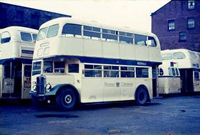 Vehicle reminder shot for this posting
Vehicle reminder shot for this posting
25/12/20 – 06:37
re. Andrew Wylie’s comment of 26/01/14 – 17:23
As nobody has answered this, may I add the following: The accident occurred about 4.50pm on Thursday 11th January 1940; it was growing dark; the bus was a Rochdale Corporation bus; it was travelling from Summit to Littleborough; the nearside front tyre burst; the driver apparently losing control of the vehicle, which mounted the pavement. Thomas Dawson (57) died along with Geoffrey Cryer (11) and Hillary Hudson (12) died in Rochdale Infirmary later of injuries sustained. (These details from Rochdale Observer Saturday 13th January 1940). An inquest was held on Monday 15th January 1940 at Birch Hill Hospital, in which the County Coroner exonerated the driver. Dawson’s widow was quoted as saying "I think you ought to know this: I do not blame the driver in any way." (The two reports are on the British Newspaper Archive in the Rochdale Observer for Saturday 13th and Wednesday 17th January 1940).
Mike Baron
